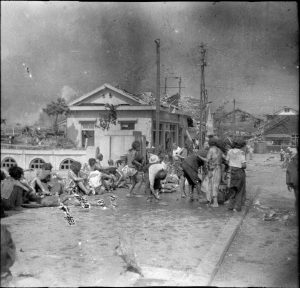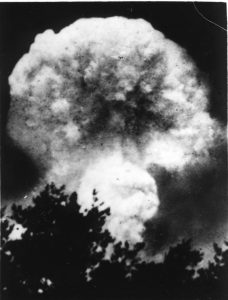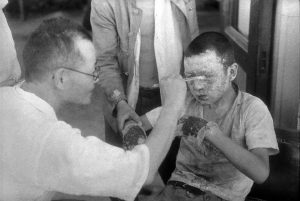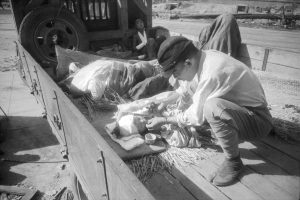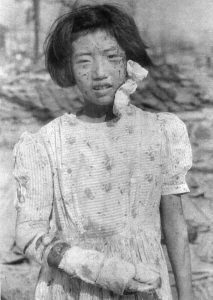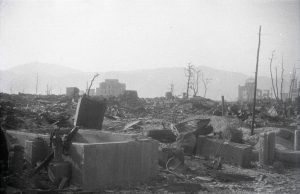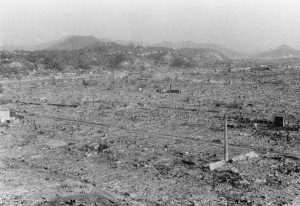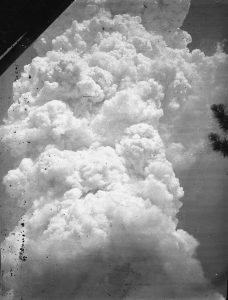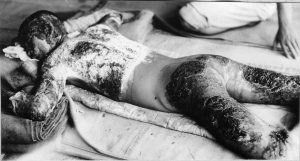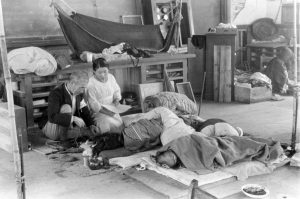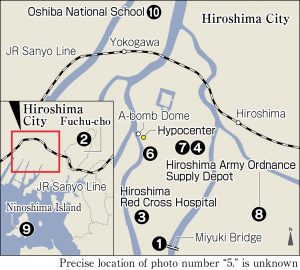Chugoku Shimbun, Asahi Shimbun, Mainichi Newspapers, Hiroshima City jointly apply for registration with “Memory of the World” of 1,532 A-bombing documentary photos from under the ‘mushroom cloud’
Sep. 18, 2023
Local individuals, photojournalists took photos of suffering survivors, ruined city
by Kyosuke Mizukawa, Senior Staff Writer
With the aim of joining to convey what happened under the mushroom cloud after the atomic bombing, the Chugoku Shimbun, the Asahi Shimbun, the Mainichi Newspapers, and the Hiroshima City government have applied jointly in Japan for registration of 1,532 photographs of Hiroshima taken soon after the atomic bombing with the United Nations Educational, Scientific and Cultural Organization (UNESCO)’s “Memory of the World” register. The photos reveal details of the tragedy resulting from the atomic bombing by the U.S. military, in the first use of a nuclear weapon in human history, and serve as a warning to humanity to ensure the tragedy is never repeated. Herein, the Chugoku Shimbun introduces a selection of the photos submitted in the application.
A total of 1,532 photos were taken by 27 individual citizens and one organization during the period from August 6, 1945, the day the atomic bomb was dropped on Hiroshima, until the end of December that same year. Unlike the aerial photos taken by the U.S. military around the same period, this photo collection captures the reality of the atomic bombing from the vantage point of people who had themselves experienced the bombing. The application was made under the title “Hiroshima A-bombing documentary photographs — From under the mushroom cloud.” The four organizations and the surviving families of the individuals who took the photos own the prints and negatives.
On the day of the atomic bombing, August 6, 1945, the first people to use their cameras to capture scenes of Hiroshima were residents that experienced the bombing themselves. Toshio Fukada, who died in 2009 at the age of 80, was 16 at the time. He snatched a camera from his pocket and took a photo of a cloud rising from the ground, after he had been knocked over by the A-bomb blast about 2.7 kilometers from the hypocenter at a site where he had been mobilized to work.
Yoshito Matsushige, a Chugoku Shimbun staff photographer who died in 2005 at the age of 92, experienced the bombing at his home and took photos of wounded survivors at the west end of Miyuki Bridge, about 2.2 kilometers from the hypocenter. Mr. Matsushige was the only person who was able to take photos of the suffering of citizens on the day of the bombing. He took a total of five photos that day.
In the bombing, the Chugoku Shimbun lost 114 employees, about one-third of its entire staff, and its head office building in Hiroshima’s downtown was burned to the ground. Other than Mr. Matsushige’s five photos, there are no other photos taken by Chugoku Shimbun employees of the A-bombing devastation in downtown Hiroshima through the end of August 1945. Meanwhile, other journalists and photographers traveled to the city from outside of Hiroshima Prefecture to record the tragedy.
Hajime Miyatake, a staff photographer for the Asahi Shimbun Osaka head office who died in 1985 at the age of 71, entered Hiroshima on August 9, three days after the bombing, and took photos that include several of a young boy undergoing treatment for his burns at a hospital and of a child with a head injury. Among all the photographers, Mr. Miyatake left behind the largest number of photos, 119, taken within one week after the bombing.
Yukio Kunihira, a staff photographer for the Mainichi Newspapers Osaka head office who also arrived in Hiroshima on August 9 and died in 2009 at the age of 92, focused his camera on a wounded young girl and the scorched ruins in the area where his company’s branch office had stood in Hiroshima. Around the same time, photojournalists from Domei News Agency, the predecessor to the Kyodo News agency, also took photos of the city.
The atomic bombing wounded many people in Hiroshima from its thermal rays and blast and caused seemingly unaffected citizens to suffer acute effects from radiation. Shunkichi Kikuchi, a photographer based in Tokyo at the time who died in 1990 at the age of 74, came to Hiroshima accompanying the Japanese Education Ministry’s Special Committee for the Investigation of A-bomb Damage in October that year. At that time, he photographed citizens suffering from ‘A-bomb disease.’ Mr. Kikuchi took more than 800 photos, including those of a mother and daughter lying down at a temporary relief station that had been established in a school.
The 1,532 photos included in the application were selected from among photos archived by the news organizations, displayed at the Hiroshima Peace Memorial Museum, and collated and published by the Association of Photographers of the Atomic Bomb Destruction of Hiroshima, an organization formed by Mr. Matsushige and other photographers in 1978. The media organizations and the city government collaborated and gained approval for the registration from surviving family members of the photographers and from Hiroshima University. By having the photos registered with the Memory of the World register, the UNESCO application aims to raise awareness worldwide about the photographic record of the atomic bombing by communicating information on the collection and by highlighting the reality of the A-bombing devastation, which resulted in the deaths of an estimated 140,000 people (with a margin of error of +/- 10,000) by the end of December 1945.
City anticipates registration of all application items, including A-bomb literature and Sadako’s paper cranes
“Memory of the World” is a generic term for initiatives that UNESCO launched in 1992 with the aim of enhancing internationally important documentary materials and promoting preservation of and access to the materials. This initiative has been implemented since 1995 as a program to register, on an international scale, documentary heritage considered to be of particular importance in human history. As of June of this year, 494 items have been registered.
Screening for the registration of such materials is held once every two years. The number of applications allowed for each country is “up to two,” which are selected as recommended items through a domestic screening process. In case of a joint application from multiple countries, this limit does not apply. At present, the application is being screened in Japan for 2025 registration. Based on opinions from specialists, Japan’s national government will determine the items to be nominated to UNESCO in November.
With relevance to the atomic bombing, a civic group called the Association for Preservation of Literary Materials of Hiroshima, together with the Hiroshima City government, jointly submitted an application for six items, including manuscripts and journals written by four authors of A-bomb literature, such as the poet Sankichi Toge and the writer Tamiki Hara. Another joint application was made for materials related to Sadako Sasaki—including paper cranes she folded—whose death from leukemia from the atomic bombing drove the establishment of the Children’s Peace Monument. The application was made by an association consisting of a group represented by Sadako’s surviving family members, as well as the Hiroshima Prefectural and Hiroshima City governments and a group from Brazil.
The city government is listed as an applicant in all three of the applications, including that for the documentary A-bomb photos, based on its stated policy of wanting to provide support to registration applications led by the private sector. The city has adopted the stance because it considers that establishing criteria and leading the selection process for submitted materials to be cumbersome, given the overwhelming amount of A-bombing materials at the museum alone.
According to staff at Hiroshima City’s International Peace Promotion Division, “We believe the three application materials meet the criteria for registration with the ‘Memory of the World,’ because they all convey the reality of the atomic bombing. We hope all will be accepted for registration.” As for international entries, materials marking the Holocaust by the Nazi party in Germany, including The Diary of Anne Frank, audio archives of interviews used for producing the movie “Shoah,” and court records of post-war trials held in Germany have all been registered through different applications.
(Names of people/organizations that took the photos)
Members of public—Masami Onuka, Masami Oki, Totaro Karasuda, Yotsugi Kawahara, Toshio Kawamoto, Mitsugi Kishida, Kichita Kishimoto, Isao Kita, Gonichi Kimura, Kazuma Hayashi, Toshio Fukada, Mitsuo Matsushige, Taichi Morimoto, and the photography corps of the Japanese Imperial Army Shipping Command.
Media organizations—The Chugoku Shimbun: Yoshito Matsushige, Seiso Yamada, Yoshie Yamamoto, and Nagaji Tanigawa; the Asahi Shimbun: Hajime Miyatake and Eiichi Matsumoto; the Mainichi Newspapers: Yukio Kunihira, Entaro Yamagami, Tatsuro Niimi, and Kishiro Watanabe; the Domei News Agency (predecessor to Kyodo News): Satsuo Nakata and Takashi Saeki.
Photographers based in Tokyo—Shunkichi Kikuchi, Shigeo Hayashi
(Titles omitted from list)
(Originally published on September 18, 2023)

